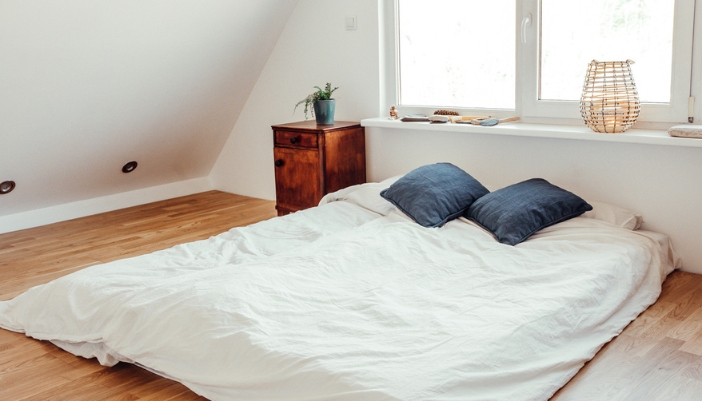Welcome to a journey through the world of sleep, a universal experience that varies intriguingly across cultures. While we all close our eyes each night, the way we do so can differ dramatically from one corner of the globe to another. Many cultures can offer unique insights into the art of slumber. In this exploration, we're not just uncovering fascinating sleep customs; we're seeking lessons and practices that could enhance our own sleep quality and inform our mattress choices.

Sleep Habit #1: Siesta Traditions in Spain
Ah, the siesta - that blissful midday nap synonymous with Spanish culture. Picture this: a tranquil afternoon in a quaint Spanish village, where the streets grow quiet, and the gentle hum of daily life gives way to a peaceful hush. This time-honored tradition isn't just a cultural quirk; it's a testament to Spain's understanding of the body's natural rhythms and the need for rest.
The siesta's origins are practical, rooted in Spain's hot climate and agricultural past. To escape the midday heat, workers would rest, rejuvenating their bodies and minds. But there's more to it than just beating the heat. Siestas are scientifically-backed power boosts. Research shows that a short nap of 20-30 minutes can significantly enhance cognitive function, mood, and even heart health. It's like a reset button in the middle of the day, offering a burst of alertness and improved performance.
Napping Done Right
Integrating siesta-like naps into our routine can be a game-changer, especially for those of us juggling hectic schedules. The trick is to keep these naps short and sweet. Long naps can lead to sleep inertia – that groggy feeling you get when you sleep too deep during the day. The ideal siesta is about 20 minutes, just enough to refresh without diving into deep sleep.
But where do we take these naps? Here's where our expertise in mattresses comes into play. For a truly restful siesta, your surface matters. A mattress that offers a balance of comfort and support is ideal for these quick rest periods. You don't want to sink too deep and start your full sleep cycle, but you also want enough comfort to relax quickly. Memory foam or hybrid mattresses are often a good choice – they're supportive yet cozy enough for a quick snooze.
Bedding plays a role too. Since the goal is to avoid getting too hot (a common siesta pitfall), breathable materials like cotton or bamboo are your best friends. They wick away moisture and help maintain a comfortable body temperature, ensuring your nap doesn't turn into a sweaty ordeal.
A Siesta for the Modern Sleeper
Adopting the siesta in today's non-stop world might seem challenging, but it's all about adaptation. For those of us who can't hit pause in the middle of the day, even a brief, seated relaxation with eyes closed can be beneficial. The essence of the siesta is in understanding the value of rest - acknowledging that sometimes, the best way to be productive is to allow ourselves a moment of peace and quiet.

Sleep Habit #2: Communal Sleeping Practices of Japan's Ainu People
Imagine a scene of harmony and togetherness in Japan's northern regions, where the indigenous Ainu people embrace communal sleeping. This practice, deeply ingrained in their culture, offers fascinating insights into the benefits of shared sleeping environments.
Communal sleeping for the Ainu is not just a matter of necessity; it's a way of life that strengthens community bonds and provides a sense of security and comfort. In a typical Ainu home, family members sleep side by side on shared bedding, fostering a deep sense of connection and mutual support.
You may not believe it, but studies suggest that sleeping in proximity to others can enhance the quality of rest and provide emotional comfort. The feeling of safety and belonging that comes from communal sleeping may reduce stress and anxiety, leading to more restful sleep.
Creating a Communal Sleep Environment
Adopting this practice in modern homes can be a unique way to bring families closer. It could involve setting up a shared sleeping space in the living room for occasional family sleepovers, using futons or mattresses that can be easily moved or stored.
It's important to choose mattresses that are both comfortable and flexible. Foam or futon mattresses are ideal, as they can be easily adjusted to suit different numbers of people. It’s also essential to consider bedding that is hypoallergenic and easy to clean, considering the shared nature of the space.
Adapting Communal Sleeping for Modern Living
While full-time communal sleeping may not be practical for everyone, there are ways to incorporate elements of it. Weekend family sleepovers or setting aside a night for kids to sleep in the parents' room can be a special experience that enhances family bonds.
The Ainu's communal sleeping tradition teaches us the value of closeness and shared experiences. By experimenting with this practice, we can discover new ways to improve our emotional well-being and strengthen family connections, all while enjoying a comfortable and restful night's sleep.

Sleep Habit #3: Night-Time Rituals of the Scandinavian Sami
Venture into the serene landscapes of Scandinavia, where the Sami, an indigenous people, have cultivated unique night-time rituals deeply connected with nature. These practices, steeped in tradition, offer insights into creating a harmonious sleep environment.
The Sami people have developed sleep rituals that are in tune with the earth's rhythms. They often involve preparing the mind and body for rest through practices like quiet reflection, herbal teas, and embracing the calm of the natural surroundings.
Immersing oneself in nature, as the Sami do, can lead to profound improvements in sleep quality. Studies have shown that a connection with nature helps regulate sleep patterns, reduces stress, and enhances overall well-being.
Creating a Sami-Inspired Sleep Environment
To bring a touch of Sami tranquility into our bedrooms, consider incorporating elements of nature. This can range from using natural materials in bedding and mattresses, such as wool or organic cotton, to introducing plants that purify the air and create a serene atmosphere.
For a sleep experience akin to the Sami's, choose a mattress that balances support with natural comfort. Latex or organic mattresses are excellent choices, offering comfort while also being environmentally friendly. Complement this with bedding made from natural fibers for breathability and a touch of nature's soothing presence.
Incorporating Sami Rituals into Nightly Routines
Adopting some Sami rituals, like a quiet period before bed or sipping herbal tea, can significantly enhance our sleep quality. These practices help calm the mind, signaling to the body that it's time to wind down and embrace rest.
The Sami's approach to sleep, grounded in their deep bond with nature, teaches us the importance of creating a peaceful, natural environment for rest. By incorporating aspects of their rituals and making thoughtful choices in our sleep setups, we can enrich our own sleep experience, aligning more closely with the natural world and its restorative powers.

Exploring Other Global Sleeping Habits
Around the world, diverse cultures offer unique and enlightening approaches to sleep, each with its own charm and wisdom. Let's journey through some of these fascinating practices, uncovering sleep habits that vary from hammocks in South America to open-air sleeping in Africa.
Hammock Sleeping in South America
In many South American cultures, sleeping in hammocks is not just a way to relax but a nightly practice. Hammocks, perfectly designed for hot climates, encourage airflow and provide a comfortable, cradling effect that can improve sleep quality. They offer a lesson in simplicity and adaptation to the environment.
Open-Air Sleeping in Africa
In parts of Africa, particularly in rural and tribal communities, sleeping outdoors is common. This practice aligns with the human body's natural inclination for fresh air and a connection with nature. The gentle sounds of the environment and the natural cooling effect of the night air can contribute to a night of deep, restful sleep.
Floor Sleeping in Asian Cultures
In several Asian countries, sleeping on the floor on mats or thin mattresses is standard. This tradition, rooted in simplicity and minimalism, is believed to offer various health benefits, such as improved posture and spinal alignment. It challenges our conventional ideas about comfort and encourages us to rethink our sleep environments.
While we might not adopt these practices in their traditional form, we can draw inspiration from them. For instance, choosing a hammock for an afternoon nap or trying a firmer mattress for better posture. Even small changes, like occasionally sleeping in a different environment, can offer fresh perspectives on our sleep habits.
These global sleeping habits highlight a universal truth: sleep is a vital, culturally rich aspect of human life. By exploring and understanding these diverse practices, we gain a deeper appreciation for the many ways people around the world cherish and honor sleep.
Our voyage through the world's sleeping habits reveals a rich mosaic of traditions, each contributing to the tapestry of global rest practices. This exploration isn't just about curiosity; it's about finding nuggets of wisdom in these practices that can enrich our own sleep experiences. Whether it's adapting our environment with the right mattress and bedding, embracing rituals that soothe the mind, or rethinking our sleep positions, there's much to learn from these global perspectives. As we integrate these insights into our routines, we not only honor these rich traditions but also step closer to achieving the restful, rejuvenating sleep we all deserve.